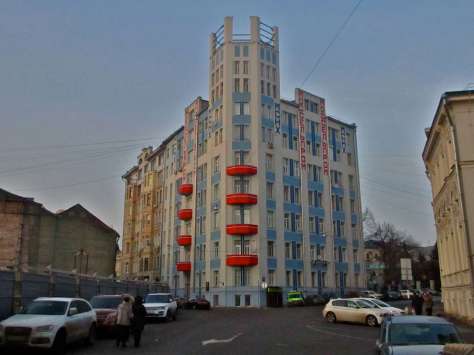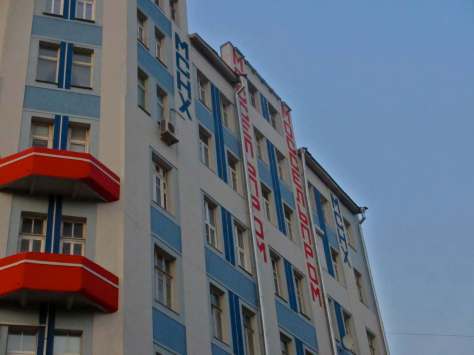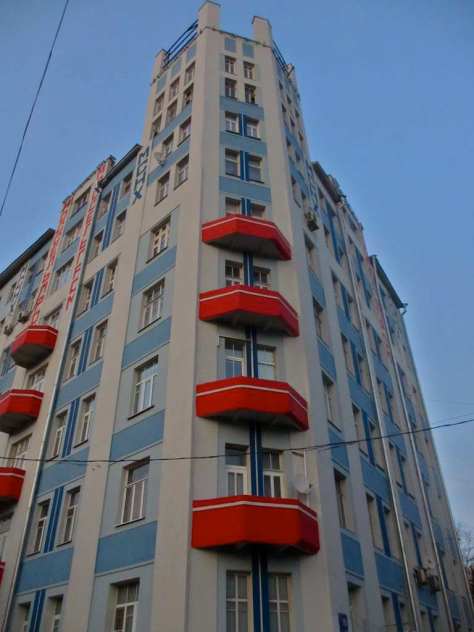Click on photos to enlarge.
Definitely one of the coolest buildings in Moscow – the Mosselprom building. It hasn’t looked as pretty as this very often over the decades. It was something like this – though not exactly – when the great avant-garde artists Alexander Rodchenko and Varvara Stepanova teamed up with the poet Vladimir Mayakovsky to decorate it in the mid-1920s. That was at the height of the NEP period – the New Economic Policy, during which private commerce was again briefly made legal in the young Soviet Union. By 1937, Mosselprom, an organization representing manufacturers and sellers of food, drink and small consumer items, was gone. The decorations and advertisements created by Rodchenko, Stepanova and Mayakovsky lasted a few years more but eventually were removed. From the early 1940s until the late 1990s the building remained a fairly dowdy one, not anything that really grabbed your attention. But in 1997 a decision was made to restore the building to its former, short-lived glory. Thus, on what I’m guessing is the eastern or northeastern-facing wall, we can again see Mayakovsky’s famous slogan, “Nowhere if not at Mosselprom!” You can see that in the second photo above, the small white letters against the narrow dark background ending in a huge red exclamation point.
I don’t know why Mayakovsky’s slogan was so famous. But it was. You almost always meet the word “famous” before the word “slogan” in descriptions of it. Maybe it was because this was a pleasant throwback to former commercial frivolity. Maybe because these were among the first-ever huge advertisements on a building – forerunners to our billboards – so that attracted attention. There is a jaunty rhythm to Mayakovsky’s phrase – nigde, krome kak v Mossel’prome – but I don’t find it anything out of the ordinary. Maybe I’m missing something. Maybe I’m too jaded by the mad men of Madison Avenue. Mayakovsky himself was of a very high opinion of his phrase. “Despite the poetic razzes, I consider [the slogan] to be poetry of the very highest qualification.” So, take that, naysayers, myself included.
There may be another reason why it became so famous – Mayakovsky and Rodchenko teamed up to create dozens of advertisements and slogans for Mosselprom in the second half of the 1920s. You can see a bunch of their advertising posters on Google. One that surely amused Mayakovsky as he wrote it was, “Better pacifiers have never been. I’ll suck them until I’m an old man.” Pardon, as the French say, but the Russian word for “pacifier” is quite simply “nipples.” But the point is that all of these ads were popular and ubiquitous at the time. Their popularity would have rubbed off on the paintings and slogans on the wall of the building.
(By the way, as a non-sequitur, may I ask all those dread bores who complain about Bob Dylan occasionally allowing his music to be used for advertisements to think upon the implications of this post? Thank you.)
The Mosselprom building bears the address of 2/10 Kalashny Lane. It is located right around the corner from the Russian Academy of Theater Arts on Maly Kislovsky Lane (RATI, formerly GITIS, actually occupies rooms in the Mosselprom building now too), and it is located next to the building on Maly Kislovsky that formerly housed the mighty Iskusstvo, or Art, publishing house. After the building’s glory years, from 1964 until his death in 1969, the great Russian linguist and literary scholar Viktor Vinogradov lived here with his library of 20,000 books. I used his books – the ones he wrote – when studying Russian at an advanced stage.
The building in its current state is rather closer to what Rodchenko intended when he created his designs in the 1920s. He had wanted his artwork to be painted on plaster covering the base construction material of bricks. However, probably in an economizing move, the original builders skipped the plaster and had the words and colors painted directly onto the bricks. The advertisements were painted on plywood boards that were hung on the walls. Today all the painting is done directly on the plaster. And, as Science and Life magazine tells us, the paints now used are a special acrylic that can withstand temperatures as low as -50 C (-58 F).
The basic building was erected in 1913 by architect Nikolai Strukov. It was expanded in 1925 especially for Mosselprom by Artur Loleit. Actually, the building has a checkered history. Parts of it fell down when it was first built and it was restructured several times. One can find all kinds of architects’ names involved in the various stages of the work. But it looks to me like Strukov answers for the basic building, while Loleit answers for what it looked like when it became famous in 1925.







